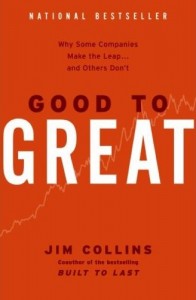 Good to Great
Good to Great
Audio Book
By Jim Collins
May 22, 2010
© Tom Arthur
Rating: 7 out of 10
Good to Great is a seductive book. It is seductive because it is very tempting to buy into the definition of “great” that Collins and his research team set to distinguish a select group of eleven companies that had “fifteen-year cumulative stock returns at or below the general stock market, punctuated by a transition point, then cumulative returns at least three times the market over the next fifteen years” (6). In other words, they made average money for their shareholders for at least fifteen years and then they made significantly above average money for their shareholders at least the next fifteen years. Collins points out that he chose this sector to study because of the easily agreed upon definition of “success”, but I am left with several questions while attempting to adapt Collins’ findings to the church that make me wonder whether the translation is possible.
First, Good to Great was published in 2001 and since then there have been several significant shake-downs with at least three of the companies (that I am personally aware of) that made Collins’ list. Circuit City no longer really exists. The domain name was bought by another company that now runs their website selling computers, but all the stores were liquidated. Also after the “Great Recession” Fannie Mae was taken over by the government, and Wells Fargo is under significant investigation for some of its banking practices. I don’t know that three out of eleven makes for a shattering of Collins’ argument, but it certainly makes me start to ask the question: am I participating in building a church that might not last much longer than a “good to great” transition period of fifteen to thirty years? The Church has a running record of 2000+ years. Perhaps there is something in the history of the church that businesses could learn from about how to have not just a fifteen-year period of success but a lasting period of significance that spans not decades but millennia. (In defense of Good to Great, building a long-lasting company was not the goal of the research in this book and is closer to the goal of his first book, Built to Last which I have not yet read.)
Second, Good to Great offers an end result of its definition of “great” that I personally do not resonate with. Take Kroger or Walgreen’s which both made the list. I do my best to avoid both of these stores and the others that are like them in favor of small locally-owned groceries, farmers, farm-markets, and pharmacies. I am not always successful at this attempt, but if I had my choice, I’d always pick something besides these big box stores. Are there other factors that must be taken into account when one considers a definition of what truly is “great”?
Third, one of the key concepts of the book is “First Who…Then What.” This concept suggests that the most important thing in a company is who you’ve got on the “bus” and not where the “bus” is going. Thus, a leader must be singly focused on getting the right people on the bus and the wrong people off the bus. Once again we’re confronted with a definition of “right” and “wrong.” What if the wrong person is a single mom currently in the position who needs the steady income to survive, but isn’t necessarily the most brilliant or competitive person for the job and is merely adequate? Are those who seek to build the community that follows Jesus’ way really willing to get this “wrong” person off the bus and another “right” person on the bus? These are complicated questions, and I’m not suggesting that this shouldn’t be done, but rather that we shouldn’t necessarily swallow whole Collins’ concepts and definition of “great” and “right.” More discernment should take place in any given circumstance or situation than simply asking the question, “Is someone ‘better’ available?”
These aren’t all the questions I have about any attempt to adapt Good to Great to the church, but they give a taste of the kinds of questions I’d want to ask before implementing many of Collins’ concepts.
On the flip side of things, there is at least one concept that I found very helpful and easily translatable: what Collins calls a “level 5 leader.” Level 5 leaders tend to come from within a company rather than being a star leader from outside. Collins describes them as “self-effacing, quiet, reserved, even shy—these leaders are a paradoxical blend of personal humility and professional will” (13). What struck me most about this was the humility. Collins describes how many of these leaders live in the same small homes they have always lived in. This seemed a concept that would not be difficult to translate to the church. Preachers have to have an odd mix of “humility” and “professional will.” We are up in front of people every week (professional will) and amazingly they come back to hear us again and again, and yet what must ultimately be at the heart of that draw is our character (humility). If we’ve got all the greatest communication skill in the world but don’t have the humility of love, what exactly are we building as preachers? Good to Great can be a very helpful book for reflecting on how one does church, but at the same time the church must not be entirely seduced by Collins’ definition of “greatness” for a business. There are other questions that a church must ask besides, are we beating the marketplace?
Currently Reading/Listening:
American Saint: Francis Asbury and the Methodists by John H. Wigger
An Introduction to Pastoral Care by Charles V. Gerkin
Sober for Good by Anne M. Fletcher
Imitation of Christ by Thomas à Kempis

Recent Comments